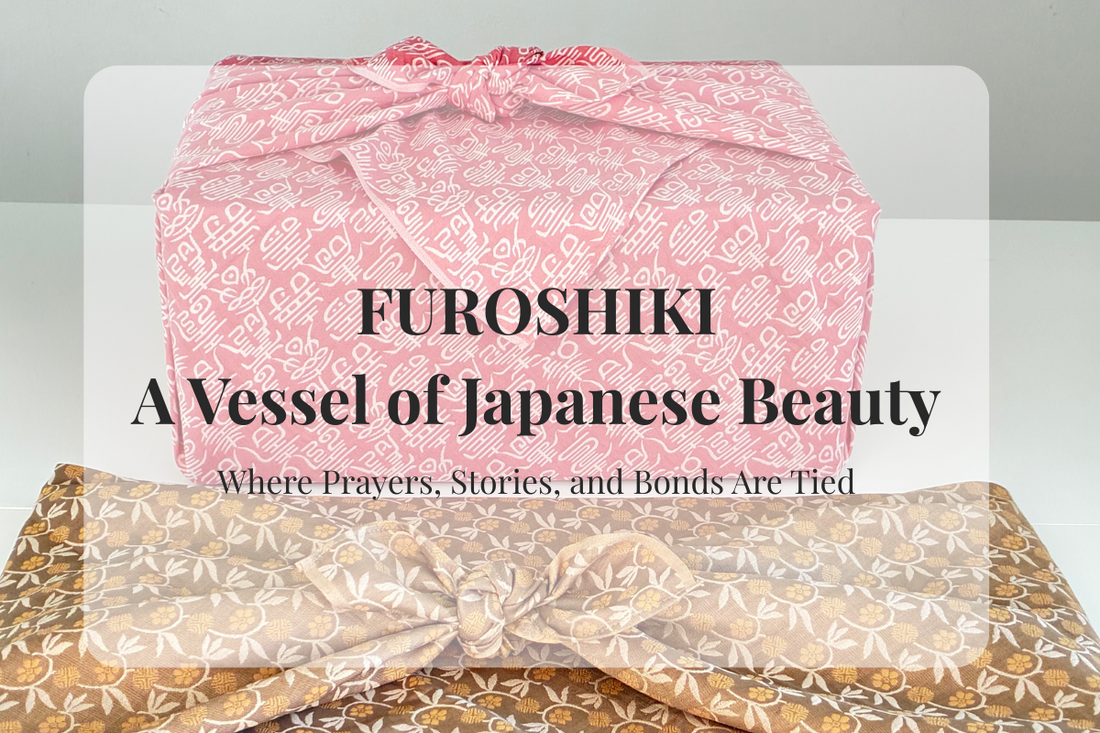
The Japanese Aesthetic in Furoshiki
Colors, Patterns, Materials and the Power of the Knot
Seeing Furoshiki in a New Light
A furoshiki is more than a practical piece of cloth for wrapping and protecting things.
It embodies Japan’s spirit and sense of beauty, a form of culture preserved in fabric.
Every color, pattern, material, and even the way it is tied carries deep meaning.
Once you become aware of the heart and craftsmanship woven into a single piece of cloth, the world of furoshiki opens up—rich, layered, and intimately connected to daily life.
Colors as Prayers
The first thing that catches the eye in a furoshiki is its color.
In Japan, colors have long been seen as reflections of feelings and wishes.
Red conveys protection and vitality, often chosen for celebratory occasions.
Yellow reflects prosperity and abundance.
Green represents harmony with nature and peace of mind.
Blue speaks of purity and sincerity, while purple carries connotations of nobility and the sacred.
Choosing a color often resonates with one’s inner feelings.
In that sense, a furoshiki could be seen as wearing or wrapping oneself in a “color of prayer.”
Patterns That Tell Stories
Patterns on furoshiki also carry meaning.
Kisshō-mon’yō, or auspicious motifs, include cranes, turtles, and pine-bamboo-plum designs, each symbolizing happiness, longevity, or prosperity.
Komon features finely repeated patterns that, while understated, create an elegant impression.
Kachō-fūgetsu patterns celebrate the changing seasons and the Japanese sensitivity to living in harmony with nature.
Then there are yūsoku patterns, historically used in the aristocratic circles of the Heian period and later incorporated into tea utensil pouches. These designs, which traveled to Japan along the Silk Road, live on as a testament to the blending of distant cultures with Japanese tradition.
The Meaning of the Knot
No discussion of furoshiki is complete without talking about the knot.
The word “musubi” (to tie) also evokes the concept of musubi written with different characters, meaning a sacred power that creates and connects all things.
This idea ties closely to kibutsu chinshi, the cultural practice of imbuing objects with one’s thoughts and feelings.
Consider the ma-musubi, or “true knot,” a firm knot that represents unchanging intentions and enduring bonds. To wrap a gift with this knot is to express a heartfelt wish to preserve the connection with the recipient.
A knot is not merely a functional closure. It seals one’s thoughts into the cloth, allowing those feelings to gently reach the recipient as the knot is untied. It is a quiet gesture of prayer and connection.
Materials Reflecting One’s Way of Life
The choice of material in a furoshiki speaks volumes about the values of its user.
Cotton is sturdy, easy to handle, and designed for long-lasting use. At MUSUBISM, we use Japanese cotton, with the hope that each piece will be cherished until its very end.
Silk, with its luster and supple texture, carries a sense of elegance for special occasions and meaningful gifts.
Synthetic fibers are lightweight, wrinkle-resistant, and ideal for everyday use.
In recent years, recycled fibers have gained popularity as a sustainable option, reflecting care for the environment.
The material you choose expresses the kind of time and lifestyle you wish to cultivate.
Fūtsūori — A Japanese Weaving Technique
Among my personal collection is a furoshiki made with fūtsūori weaving.
This is a double-weave technique where the warp and weft threads are different colors, creating a pattern that reverses on the front and back. The structure is pouch-like, with space between the layers, which is why it is called “fūtsū,” meaning “wind passes through.”
The result is a fabric with visual depth and a soft yet resilient texture. Historically, this technique was used for kimono fabrics, obi belts, and tea utensil pouches, giving it a sense of prestige.
As a furoshiki, fūtsūori offers two contrasting faces, allowing for creative and playful presentation each time it is used.
What a Single Cloth Holds
It’s natural to notice the colors and patterns when choosing a furoshiki.
But when you take a moment to learn the meanings and stories behind them, the cloth reveals a deeper charm.
Colors embody prayers. Patterns tell stories. Materials reflect your way of living. Knots symbolize heartfelt connections.
A furoshiki, in its quiet presence, is a vessel holding the essence of Japanese sensibility.
Next time you unfold one, pause to feel the wishes and thoughts it carries.
That simple act may turn an ordinary moment into something a little more intentional, a little more beautiful.
